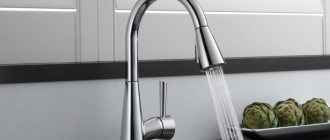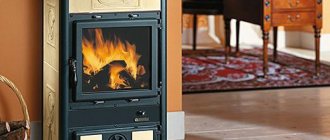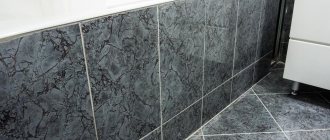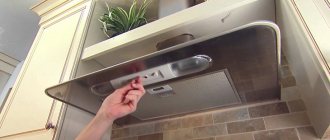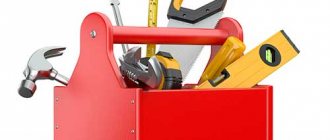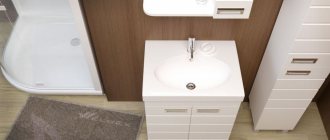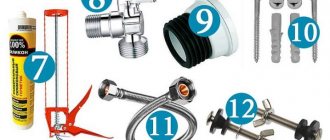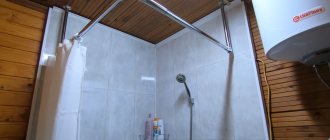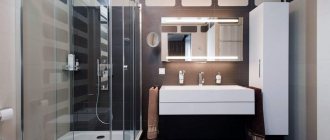Everyone has their own aesthetic preferences, which is why the variety of styles in bathroom interiors is enormous. However, almost everyone is unanimous on one issue: the lower part of the bath from the sides should be closed. For this purpose, special bathroom screens are used. They are light, beautiful and easy to install.
Bathroom screens are needed to disguise unsightly details, the space under the bathtub, and sometimes to gain additional space for storing household items.
A few decades ago, these functions were performed either by light curtains or by blank brick walls trimmed with tiles.
How to select a screen
A bath screen is a rigid structure made of a frame and hinged, sliding or blind (tightly fixed) panels. They are installed on the outside of the bathtub (with the exception of a free-standing bowl, where decorative protection is installed around the perimeter). There is a huge selection of protective screens on sale based on frame and panel materials, design and design features. Therefore, choosing a beautiful, easy-to-install product without preparation is difficult. We fill the gap and note the parameters that you should pay close attention to when purchasing a screen:
- functionality - how important is free space under and around the bathtub for the housewife: it will be used to store household chemicals, leftover building materials, etc. or the screen will serve as a screen hiding plumbing communications;
- complexity of installation. Here you need to consider two points: is it possible to do the work yourself; Is it possible to install the type of screen you like on an acrylic bathtub?
- cost of the product - for many families this criterion is very important, because the price of a factory screen can range from 300 to tens of thousands of rubles;
- durability - ideally, the service life of the screen should coincide with the service life of the bathtub;
- dimensions - determine the dimensions of the set for the installed bowl;
- appearance - depends on the aesthetic preferences of the owners.
Functionality
Installing a screen on a corner acrylic bath solves several problems at the same time:
- hides water pipes, siphon, frame and walls of the bathtub;
- completes the interior design of the bathroom;
- creates a closed space for storing household chemicals and care items for acrylic and plumbing fixtures of the room.
You can buy screens for specific tasks:
- with sliding doors - a classic of the genre, the easiest to install, practical and easy-to-use option. Performs simultaneously all the tasks assigned to this element of acrylic bowl arrangement;
- swing - an improved type (replica) of a sliding structure. Instead of doors, doors are attached to it. But such a screen can only be installed in a spacious room - you need space to open the doors;
- deaf. The consumer immediately has a question: how to maintain plumbing equipment in this case? The answer is simple: blind versions of decorative panels are removable, attached with magnets (available for bathtubs of original shapes and sold together with the bowl) and stationary with a hidden hatch for access to the siphon. This type of decoration of the walls of the font is characterized by simple installation, increased strength and high aesthetics (designers claim that a solid surface looks more attractive than one divided into sections or doors). But it will not be possible to store any objects or things behind such decor.
Sometimes you can find sliding curtains made of film or fabric instead of screens. They perform the same functions, but it is difficult to classify them as screens. This is most likely a decorative element in the design of the font bowl.
Difficulty of installation
The most difficult way to attach a screen to an acrylic bathtub with hinged doors. But this is in comparison with a blank panel. If we evaluate the technology as a whole, then any representative of the human race who has ever worked with a screwdriver can install a screen of any type - there are no difficulties in the instructions.
Price
The difference in screen prices is significant. Plastic models can be bought for 300-700 rubles, from MDF for 4,500-8,500 rubles, and from cast acrylic for 30,000-45,000 rubles.
Durability
The service life of the protective panel is influenced by the type of materials from which the frame with fasteners, fittings and sashes (doors) are made.
Manufacturers offer the frame in several versions:
- made of plastic;
- become;
- aluminum
The plastic frame is the cheapest, with a sufficient level of strength for gentle operation. But the strength laid down by the manufacturer is not able to withstand an accidental kick on the rack - it crumbles, without the possibility of restoring the structure.
The steel parts of the frame cost about 3 times more than their aluminum counterparts, but they will also last longer, because... In practice, cases of deformation of aluminum screen elements are observed. Fittings can be made of plastic, brass, aluminum and steel. The most durable handles are made of galvanized steel. Brass and aluminum are prone to corrosion in humid conditions.
Plastic by its nature does not last long. The problem most often occurs in painting - peeling.
The screen doors can be:
- made of plastic - they can serve for a very long time, but having increased fragility, they are easily damaged by mechanical stress;
- plexiglass (plexiglass). The material has the same problem as plastic - high fragility;
- MDF is the most suitable option in terms of service life;
- cast acrylic - corresponds to the service life of the bowl;
- Tempered glass is expensive, but will last a long time.
Size
Most often, a protective plastic panel coated with a thin layer of acrylates is also sold along with an acrylic bathtub. This allows you to get a screen that is perfectly sized to the font and has a tone that matches the sanitary ware. This approach is especially relevant when buying a bowl of an original shape - it is unlikely that you will be able to select a screen. But such panels are sold only in a solid version, which many housewives do not like - there is no way to hide small household items that are used in the bathroom. Therefore, most often the screen is purchased separately or installed independently from scrap materials.
If the panel with the frame is not purchased as a set, then before going to the retail outlet, the length of the bowl and its height above the floor level are carefully measured. If the exact dimensions of the screen are not on sale, you need to buy with a small margin - the excess length can always be cut off with a grinder, and the height can be adjusted using the legs of both the bowl itself and the frame under the panel.
Design
Screen doors (doors) can be made from several types of materials:
- plastic. Such screens can have a variety of textures and colors, as a result of which choosing a screen to suit the interior of a particular room will not be difficult. But the design as a whole looks in accordance with the price - not rich;
- plexiglass. Matte or mirror surfaces look very impressive, giving the room a special charm. But installing such a screen without a thoughtful design of the entire room sometimes leads to dissonance in the interior;
- MDF panels. Looks expensive, stylish, fits perfectly into any interior;
- cast acrylic Used for round or asymmetrical bathtubs (sold together with the bathtub, as it is impossible to choose). You will have to pay a decent amount for such a panel, but it is worth it - it looks great, creating a single whole with the bowl.
When making a screen yourself, the panel can be made of plasterboard, painted with water-based paint, boards or ceramic tiles (glued to gypsum board).
Decorative tiled screen on a brick base
The advantage of a decorative screen on a brick base is reliability and durability. Disadvantage - the monolithic structure consists of difficult-to-replace elements. Instead of tiles, you can glue plastic panels.
Make markings on the floor surface.
- Lay the first row of bricks. The second row is laid after 24 hours. During this time, the cement mortar will completely set and dry. Shift each subsequent row 1-2 cm to the side.
- Place a brick wall under the edge of the bathtub. Leave space for a technical opening.
- Cover the finished structure with a primer mixture.
- Apply adhesive over the primer.
- Lay the tiles on the glue and leave to dry.
- Treat the joints with sealant.
- Insert the decorative plug into the technical opening.
Materials and tools
Before starting work on installing the factory panel, you need to buy the screen itself and select a set of tools (buy, rent, borrow from friends or neighbors).
The kit should include:
- sashes - 2-3 pcs.;
- frame consisting of 2 (preferably 3) vertical posts and 2 horizontal ones;
- legs;
- pens;
- screws for fastening handles (2 per handle);
- self-tapping screws for attaching the frame to the bowl.
Attention: manufacturers increasingly began to supplement kits with screwdrivers for screws and self-tapping screws, and wrenches for legs, and therefore they will be superfluous in the tool kit.
Tools you will need:
- screwdriver with drill and bits: slotted and cross-shaped. The tool will be needed for drilling holes for handles, and also as a replacement for screwdrivers;
- roulette;
- construction pencil or marker;
- level;
- wrench, if not included;
- silicone sealant.
The nuances of installing a screen under an acrylic bathtub
The installation principles are the same for all types of structures. The sequence is described in detail in the manufacturer's instructions. However, there are nuances to installing non-standard forms.
For example, decorating round or trapezoidal bowls will require the construction of a frame. Craftsmen recommend using plastic, flexible PVC lining.
For the frame, a galvanized special profile for drywall is taken.
Tools required for installation:
- tape measure and marker,
- screwdriver,
- building level,
- silicone sealant,
- construction adhesive,
- rags.
How to quickly remove the screen without damaging it
It is almost impossible for an untrained home craftsman to remove the screen from an acrylic bathtub without damaging the panel. You need to know the type of fastening. However, not everything is so complicated in the end if you know some of the nuances.
- If there are no supports between the bottom of the screen and the floor, then the panel is secured in one of three ways: self-tapping screws, magnets or using springs.
- The supporting legs of the screen frame indicate that it is installed sideways.
- Direct fastening of the panel to the floor indicates the presence of spring clips.
With this information, you can easily remove the screen.
Fastening with self-tapping screws. The panel hanging above the floor should first be inspected for the presence of plugs. If they exist, then the problem is solved in two steps:
- decorative plugs are carefully removed using a sharp blade;
- Use a screwdriver to unscrew the screws.
Magnets. If there are no plugs, the panel quietly pulls down. If a little effort is not enough to tear the screen out of place, it means it has magnets on the bottom and latches on top. It's easy to remove - just pull the top towards you. In this case, it is advisable to perform the operation with several hands, so as not to distort the screen too much.
Springs. Pull the panel down and out from under the side. After this, disconnect the springs from the hooks.
Attention: if there are no plugs, and attempts to remove the panel by other methods were unsuccessful, it means that the screen is still on screws, and the heads of the hardware are skillfully masked with sealant by a good craftsman. In this case, a needle will help - in the supposed locations of the screws you need to carefully prick the acrylic (plastic). Acrylic (plastic) will resist, but the sealant will puncture easily. Then it’s simple: the homemade plug is removed, the hardware is unscrewed.
Installation by surprise. The presence of a frame is indicated by the legs. In such options, the screen is attached to the acrylic bathtub by surprise. To remove the panel, simply screw the legs into the frame and then pull them towards you.
Spring latches. The panel is removed from the spring clips in two steps:
- the upper edge of the panel is pulled towards itself until the clamps are released;
- the screen is raised up to release the latch tab from the clamp attached to the floor.
Choosing a model: important nuances
First, decide on a design that is suitable for your purposes. The most convenient options:
- Blind stationary model with a technical opening without a door. This design is usually preferred by craftsmen who do everything in the house themselves. It is simple, convenient for access to pipes, but does not involve arranging a mini-storage area under the bathroom.
- Removable stationary model without technical opening. If you choose a similar model, then try to choose a panel that can be easily removed if pipe repairs are necessary.
- Screen with hinged doors. If the bath is spacious, then no problems will arise at all. If the room area is small, carefully calculate the size of the doors so that they do not take up the entire bathroom.
- Model with sliding doors. This is a universal screen that will be appropriate in any bathroom.
When choosing, you need to pay attention to the type, dimensions, design of the structure, type and performance properties of the material
Before purchasing, measure the space that needs to be covered. Standard screens have a length of 1.5, 1.6 or 1.7 m, a width of 0.5, 0.55 or 0.6 m. There are also models of other sizes.
So, on sale you can find screens 1.05x0.5 or 1.9x0.5 m.
If you set a goal, you can find a model for any bathtub. The only difference is that among screens of non-standard sizes, models with unusual designs or with unique decor are less common.
If you are satisfied with a design with a smooth, monochromatic surface, then this option can be found in any size.
Sometimes doubts arise regarding the required width. This happens when the screen is selected before finishing work in the bathroom is completed.
Often the owner himself does not know the exact dimensions until the bathtub is installed and the tiles are laid on the floor.
The problem with selecting a model of the required width is also relevant in cases where the floors of the room have a slope. This can be solved using a screen on adjustable legs.
During installation, the legs are set to the desired height on each side.
Models with adjustable legs need to be selected according to length, because... The width can always be adjusted. Adjustable screens come in plain colors or with a variety of decorations
What and how can you make a screen with your own hands?
You can make a screen with your own hands. The technology is simple:
- The bathtub is being tied up. The material can be brick, wooden beam, metal profile. At the same time, any of the above materials are suitable for rectangular bowls; for semicircular corner baths, brick and a special aluminum profile (it can be given any rounding). During the work, it is important not to forget to make a harness under the hidden hatch through which the bathtub siphon will be serviced;
- You can immediately attach ceramic tiles to the brick, and cut-to-size sheets of gypsum plasterboard are screwed onto the frame with self-tapping screws;
- a finishing finish is applied to the drywall (mostly ceramic tiles).
In conclusion, choosing the right screen will make the task easier: no need to adjust anything, just install. The instructions for all types of fastenings are simple and easy to follow on your own.
What types of screens are there?
Now you can buy bath screens of any design and made of any material. Manufacturers of decorative panels involve experienced designers in the design of models.
They develop original designs that can fit into even the most sophisticated interior.
For the manufacture of screens, plastic, metal, MDF, polystyrene, plasterboard, polyvinyl chloride, and acrylic are used. Patterns, subject pictures (photo printing), and decorative elements can be applied to the surface of the product.
Often there are models made from combined materials.
Frames for modern screens are made of aluminum, steel or plastic. Buyers often choose models with aluminum frames, because... they are durable and affordable
Glass and mirror screens look very original. They are used not only for their intended purpose, but also to model the space of bathrooms.
For such panels, they use not ordinary glass, but organic glass, because it better resists mechanical damage and shock.
When choosing a material, you should pay attention to its strength, resistance to moisture and high temperatures. A high-quality model can last for decades.
Good performance characteristics imply a higher price for the structure, but this is the case when the investment is completely justified.
Lattice-shaped models are chosen by people who care about good ventilation of the space under the bathroom. This helps to avoid the appearance of dampness, fungus and unpleasant odors.
Popular bath screen models and prices
Screens come in different prices - from cheap plastic to expensive products from large companies. Buyers pay from 500 to 700 rubles for plastic structures.
Edelform
Products from the Swiss design bureau Edelform create a feeling of comfort in the room. Distinctive features of the company's products:
- natural shapes and shades;
- simplicity combined with functionality;
- elegance of smooth lines.
The screens are equipped with inserts for arranging niches, which increases their functionality. The front part is made of waterproof MDF panels. Cost - about 5800 rubles.
Edelform screen for bathtub.
Rocaelegance
The company's models are distinguished by their elegance. High quality workmanship and simple installation - the room is transformed in a few minutes. The set includes 3 legs that increase the stability of the structure. Screen material - VMDF. The doors have beautiful protruding handles. Cost - 4600 rubles.
How to install on corner models?
For corner bathtubs, mounting is most often provided not with self-tapping screws, but with special magnets and metal plates. Such magnets are initially attached to the legs of the font.
STEP 1. Height adjustment. Just as in the case of the rectangular model, we adjust the height of the legs based on the screen parameters.
STEP 2. How to attach the plates? On the back side of the panel, in the places where the magnets will rest, we glue the metal plates from the kit with double-sided tape or silicone sealant. While drying, you can secure them with regular tape.
STEP 3. Installation . We apply the front panel and check that the magnets grab the metal plates.
This installation option is convenient because the question: how to remove the screen and then put it back on again does not arise. Everything is extremely simple, you need to apply a little force by pulling the panel towards you, and you can just as easily return it to its place. The previous method is no different from this simplicity; there you will first need to unscrew the screws.

